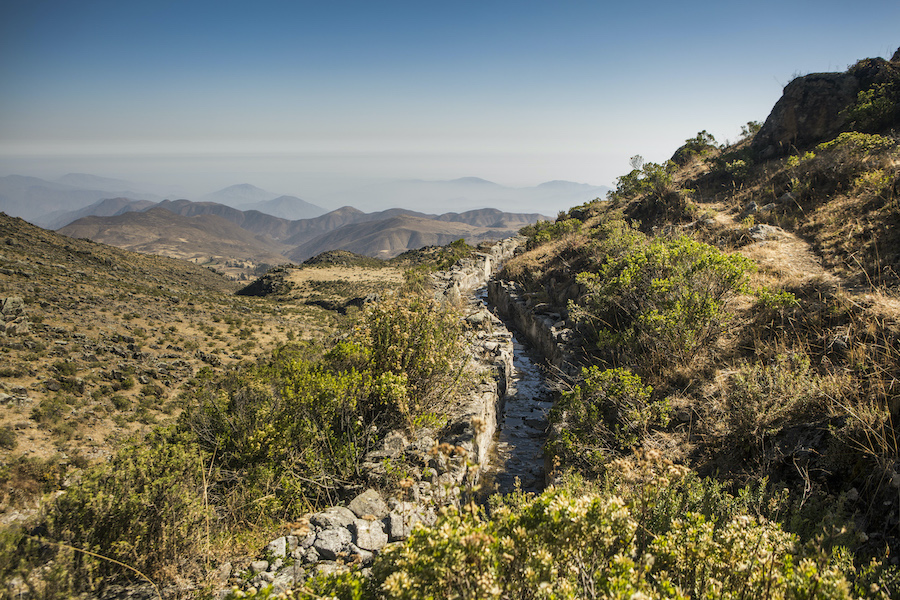 Earth & Space
Earth & Space
Ancient water harvesting practices can help solve modern problems
Ancient inhabitants worldwide have coped with seasonal rains, and flashy river flows by ‘sowing water’ during rainy seasons and ‘harvesting’ it during dry periods. We found that upscaling such a system developed by pre-Inca cultures in Peru can contribute to solving the ongoing water stress of arid coastal cities.

Some people might think that indigenous knowledge is outdated and less valuable than mainstream knowledge. However, revaluing ancient wisdom can help solve some of the most challenging problems in modernity. One important example is that of supplying water to large urban populations located in water-scarce regions. For centuries, indigenous peoples have used nature-based solutions for water. The qanats in the Middle East and northern Africa consist of tunnels and water wells that harvest groundwater in the desert. The paar systems in western India collect rainwater that penetrates through the sandy soil. In mountain regions worldwide, diverting water from seasonal rivers to spread it in permeable lands is a common practice that allows using the soils and fractured rocks as natural water reservoirs.
However, the obvious question is how to scale these systems up to meet cities' water demand. For example, the capital of Peru, Lima, is the second biggest city in South America, after São Paulo, Brazil, and the second world's biggest city located in a desert, after Cairo, Egypt. Under these conditions, Lima depends on water flowing from the Andes Mountains or transferred from the Amazon basin. The classic approach of using "grey" infrastructure, such as dams and reservoirs, involves many technical challenges, high costs, and huge environmental impacts. Moreover, grey infrastructure has limited flexibility to adapt to increasing crises such as climate change. In contrast, the use of nature-based solutions or "green" infrastructure is attracting a lot of attention from conservationist NGOs, governments, and international funding bodies as a potential alternative for water security. The problem is, however, that there is not enough evidence yet that green infrastructure can solve water problems at such a big scale.
Our paper provides this evidence by studying a pre-Inca infiltration system called "mamanteo", locally, or "amunas", regionally. This system has been in operation for at least the last 1,400 years in the Andes of central Peru. They consist of canals that divert water from small headwater streams and spread it on hillslopes with shallow soils and fractured rocks. The water infiltrates and migrates downslope through the soil, where it feeds natural springs that are used for human water supply, agricultural irrigation, and livestock grazing during the dry season.
To quantify the time that water remains inside the soils, we injected a fluorescent dye tracer in one of the infiltration canals. We then monitored where and when it emerges back to the surface using activated charcoal samplers in the springs. To quantify the estimated volumes of water that can be diverted from natural streams to the infiltration system, we measured rainfall and streamflow in the areas immediately upstream of the system intakes. Lastly, to estimate its regional potential, we developed a model that simulates replicating this system under similar conditions to the highland areas of the main river that provides water to Lima. The model uses satellite rainfall data from NASA and long-term river flow data from the National Service of Meteorology and Hydrology of Peru.
The tracer experiments reveal that infiltrated water is retained in the soils for an average of 45 days before resurfacing, which confirms that the system can delay water from the rainy season into the dry season. At a local scale, we found that only around one-quarter of the rainfall in the area becomes streamflow. About one half of this amount can be diverted effectively to one intake of the infiltration system (considering environmental flows and feasible dimensions). On a regional scale, we estimated that approximately 80% of water originates during the short rainy season, which multiplied by the previous one quarter and one-half amounts for 35% of the total river flow at the city's water supply abstraction point. Shall this volume of water be diverted to an up-scaled version of the indigenous infiltration system - combined with the currently available grey infrastructure - this could provide an extra 99 million cubic meters of water to Lima's water supply. The setup would increase dry season flows by 7.5% on average and up to 33% during the first dry months.
These results provide promising insights into the potential of scaling up green infrastructure to provide solutions to water-related problems at large scale. This also shows that revaluing indigenous knowledge, practices, and systems can complement more established scientific and engineering options, and thus to improve the water security of vulnerable populations facing climate change elsewhere in the world. We hope that this example of knowledge integration can stimulate similar research in other scientific fields and can be adopted efficiently in policy-making.
Original Article:
Ochoa-Tocachi B, Bardales J, Antiporta J et al. Potential contributions of pre-Inca infiltration infrastructure to Andean water security. Nat Sustain. 2019;2(7):584-593.Next read: Why does biodiversity matter for agriculture? by Matteo Dainese , Emily A. Martin , Ingolf Steffan-Dewenter
Edited by:
Massimo Caine , Founder and Director
We thought you might like
More from Earth & Space
Discovery of the first radiation belt beyond the Solar System
Jan 27, 2025 in Earth & Space | 3.5 min read by Juan Bautista Climent OliverOne million (paper) satellites
Jan 24, 2025 in Earth & Space | 3 min read by Ewan Wright , Andrew FalleVolcanic Ash: A Nutrient Boost for Reef-Building Corals
Sep 18, 2024 in Earth & Space | 4 min read by Frank Förster , Tom SheldrakeAmmonia Energy: A Call for Environmental Awareness
Aug 29, 2024 in Earth & Space | 3.5 min read by Matteo Bertagni , Robert Socolow , Amilcare PorporatoLikely increase in coral thermal tolerance at a Pacific archipelago
Dec 29, 2023 in Earth & Space | 3 min read by Liam LachsEditor's picks
Trending now
Popular topics


